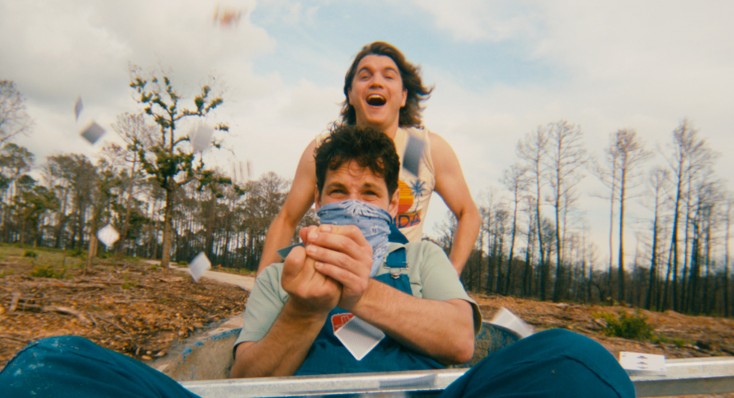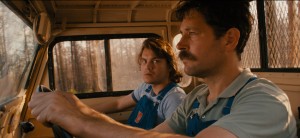By ANGELA DAWSON
Front Row Features
HOLLYWOOD—No one would imagine the mundane occupation of striping roads would serve as the backdrop of a poignant dramedy about the relationship between two very different coworkers, and yet that is precisely the setting for filmmaker David Gordon Green’s whimsically titled “Prince Avalanche.”
Emile Hirsch stars as a young slacker named Lance who accepts a job striping roads alongside veteran roadman (Paul Rudd) who takes his tedious job very seriously. The two opposite personalities are stuck together in a remote part of Texas following a devastating wildfire that has scarred the countryside around them. Cut off from the rest of the world—the movie is set in the pre-cell phone 1980s era—the colleagues do their best to get along for weeks together on the road. They talk, they argue, they get drunk, they argue some more and occasionally run into some of the locals.
Green, whose previous credits include the acclaimed independent features “George Washington” and “All the Real Girls,” was inspired to write the film after viewing the 2011 Icelandic film “Either Way.” The Little Rock, Ark. native says he thought it would be interesting to set the film in the U.S. and rewrite the characters. Hirsch saw the character as an opportunity to shed his Chris McCandless nature lover character from “Into the Wild.”
Green and Hirsch recently spoke about their collaboration, which had been nine years in the making. They shot the film in central Texas, shortly after the 2011 Bastrop County Complex Fire, which destroyed 1,645 homes, burned more than 34,000 acres and killed two firefighters.
Q: Emile, why did you want to do this film?
Hirsch: First and foremost, it was a chance to work with David. We almost made a film together eight or nine years ago. It just never happened. So I’d been plotting and waiting and this came about. Additionally, I loved the script when he sent it to me. The chance to be able to play a flipped perspective of the character I played in “Into the Wild,” where he loves nature and he is this very self-sufficient, productive guy. To now play this very immature guy who hates being alone and just wants to go back to the city to get drunk and get laid, and not develop himself emotionally, I found that to be very interesting. Partially, because I’m so sort of, in a lot of people’s minds, firmly identified with that (outdoorsman) type of perspective, so to kind of flip it around, there was kind of a perverse pleasure in it. People assume I’m this camping, hiking, fishing guy, and there’s a part of me that loves nature and loves the outdoors, but there also exists in me a city house cat facet to my personality, which I was happy to embrace.
Q: You don’t really think of the guys that paint the stripes on the road, do you?
Green: My dad’s friends with the guy who makes the paint. He was kind of a technical adviser on the movie because we had to come up with a paint that we could wipe off the road. It’s harder than you think; especially, when you have those little fragments and reflective qualities in it.
Q: In the original Icelandic movie, were they painting the road?
Green: They were, but they were a little more manly. They did it by hand. The Icelandic film was a great inspiration not only in terms of it being a character piece but I liked the meditative quality of the profession. I’ve had jobs in factories. I’ve worked at a doorknob factory, a medical supply factory and a couple of these jobs where by doing something so routine, precision so exact, consistent throughout the day, especially when you’re accompanied by these little sounds and things like that, it really gives you a place to meditate and opens your mind, rather than closing it off.
Q: I can’t imagine spending two months together with someone like that?
Green: If you were with someone as charming as Emile Hirsch or Paul Rudd, you’d be delighted.
Q: How did you create these two characters?
Green: I just wanted to create an experience for the audience where there would be enough of a back and forth, “Odd Couple” dynamic, where you could get the real contrast of these characters, and how they complement each other in a strange way that starts to evolve through the narrative. I also greatly identify with both of these characters. I see them as different sides of myself and I think audiences can see elements of themselves or people they know, and invest themselves in the characters like I did. It was a fun way to develop a film too. Typically, you’ll see a movie and you either relate to the characters and scenarios or you don’t. With this, I got to watch the Icelandic film, and I got an opportunity to see myself in these characters and then think, “Well, what if I really did embrace them? What if they said what I would say instead of what they said?” It was a cool way to get an ownership of it.
Q: Filming this in the aftermath of the Texas wildfire devastation, did it inform your performance?
Hirsch: At times, the heat and the barren nature of the forest, sort of appealed to the boredom in me, where I was like, “Oh, there’s nothing to do out here and it’s so hot.” I was able to transfer that into the character.
Green: There’s always this umbrella of melancholy all over it, even the scenes and the notes that get humorous in the movie, there’s a haunted quality there. We tried to use the music to create a harmony with the landscape, and the characters and performers are just in the foreground with their narrative. Characters like Joyce Payne, the woman who Paul Rudd’s character encounters, going through the ashes of her home looking for her pilot’s license, that was a real fire victim. When were in production on the movie we were looking for the house where Paul does the pantomime scene, and we stumbled upon Joyce and we said, “Why don’t we integrate her into this movie and tell her story.” So we were lucky to find this strange, almost mystical story she was telling and so we wove her into the story as the mysterious co-pilot of the truck. Having those opportunities to bring a real sensitivity to the reality of the devastation of a forest fire was great.
Q: How did you learn to draw the lines in the road?
Hirsch: There was a technical adviser we had with the machine. Most of the training concerned this propeller, which was on the paint machine. Because it was an older paint machine, if you put your hand anywhere near this propeller, it would have just ripped it off. I asked the adviser why the propeller wasn’t covered and he told me “no, there’s really no reason. On all the later models, there’s this little metal barrier.” So, most of our training was not to get our hands ripped off because it was a very dangerous machine. If it had gotten hold of your clothing, it would have sucked you in.
Q: Why did you set this in the 1980s?
Green: It’s a device to keep our characters isolated so there are no cell phones or emails back home or Skype—all these things that keep us connected today. I love the romance of a handwritten letter. I started with that and then created a world around that. I wasn’t looking for it to be in a specific year or a specific place. I wanted it to look like it could take place anywhere, like Romania.
Q: Emile, your character is really into comic books. What comic book would you take with you if you were alone for a long time?
Hirsch: I was always a big “Calvin and Hobbes” fan, “The Far Side,” as well. Those are my two favorite comics, although I did read “X-Men.”
Q: Lance is a bit of a drifter who takes odd jobs to survive. Have you ever had any menial jobs before you became an actor?
Hirsch: This was the menial job. (He laughs.)
Q: Have you known guys like him?
Hirsch: Oh yeah. Most of my friends are very rarely employed so I totally got that. That’s business as usual.
Q: What’s next for each of you?
Green: I just finished a movie called “Joe” that will be at the Venice Film Festival, which will be fun. And I just finished shooting the fourth season of this HBO series I work on called “Eastbound and Down” and I’m starting a new movie called “Manglehorn” (starring Al Pacino) in the fall.
Hirsch: I worked on a film that Peter Berg directed called “Lone Survivor,” based on Marcus Luttrell’s book. It’s about Navy SEALS mission called Operation: Red Wings that took place in 2005. That’s coming out in December. I also did a four-hour miniseries about (bank robbers) Bonnie (Parker) and Clyde (Barrow) that’s called “Bonnie & Clyde” that will air on The History Channel, A&E and Lifetime on December 1-2. It’s kind of a reimagining of that story.
Q: Did you have to train for the Navy SEALS role?
Hirsch: Sure. We had Navy SEALS kicking our ******.
Green: He was jacked (during production on “Prince Avalanche.”) He would take pictures of himself in the mirror flexing his muscles. I was impressed.






